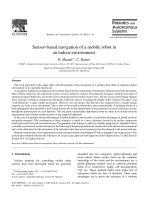Tài liệu Skin and Hair Health docx
Bạn đang xem bản rút gọn của tài liệu. Xem và tải ngay bản đầy đủ của tài liệu tại đây (410.11 KB, 12 trang )
Skin and Hair Health
305
Skin and Hair Health
How our skin and hair look is important to many of us. At the
same time, your skin and hair are organs that do special jobs
that support life. Skin protects your inside organs from injury,
bacteria, and viruses. Your skin, hair, and sweat glands help
control body temperature. Body hair also alerts you to heat and
touch. You can take steps to keep your skin and hair healthy.
You can also look to your skin and hair for clues to your overall
health. And, as a bonus, good skin and hair care will help you to
feel your best, too.
Caring for your skin and hair
Good skin and hair care involves:
l
eating a variety of healthy foods rich
in vitamins and nutrients
l
keeping physically active
l
managing stress
l
practicing sun safety
l
limiting alcohol
l
not using tobacco and other
recreational drugs
l
drinking plenty of water
Unhealthy behaviors can take a toll on
skin and hair. For instance, habits like
smoking and sunbathing dry out skin
and cause wrinkles.
Caring for your skin
Follow this simple skin care routine to
keep your skin healthy and radiant:
l
Bathe in warm—not hot—water using
mild cleansers that don’t irritate. Wash
gently—don’t scrub.
l
Keep skin from drying out by drinking
plenty of water and using gentle mois-
turizers, lotions, or creams.
306
The Healthy Woman: A Complete Guide for all Ages
l
Practice sun safety to prevent skin
cancer. Sun exposure puts you at great-
er risk of skin cancer, whatever your
skin color or ethnicity. To protect your
skin:
• Limit exposure to the midday sun
(10 -4 ).
• Wear protective clothing, such
as wide-brimmed hats and long
sleeves.
• Use sunscreen with a sun protection
factor (SPF) of 15 or higher and with
both UVA and UVB protection.
• Avoid sunlamps and tanning booths.
l
Check your skin for sun damage. Tell
your doctor about changes on the
skin, such as a new growth, a sore that
Age Spots
Years of sun exposure can cause at,
brown spots called “liver” or age spots
to appear on your face, hands, arms,
back, and feet. They are not harmful.
But if the look of age spots bothers
you, ask your doctor about skin-light-
ening creams, laser therapy, and cryo-
therapy (freezing). Use sunscreen to
prevent more age spots.
doesn’t heal, or a change in an old
growth. Ask your doctor how often
you should have a clinical skin exam
to check for signs of skin cancer. (See
pages 53 and 54 of the Cancer chapter
for more information.)
l
Ask your doctor if the medicines you
are taking can affect your skin. For in-
stance, blood thinners and aspirin can
cause you to bruise more easily. Some
antibiotics and vitamins make skin
sunburn more easily.
Skin and hair: Clues to overall
health
Healthy skin and hair are signs of good
overall health. Some skin and hair
changes can signal a health problem. For
instance, a “butterfly” rash on your face
can be a sign of lupus. Distinct rashes
appear with some viruses, such as the
measles and chicken pox. An allergic
reaction can cause hives, redness, and
itching. Diabetes and thyroid disease can
cause hair loss. Knowing how your skin
and hair normally look and feel will help
you notice changes to ask your doctor
about.
Skin and Hair Health
307
Nail Health
Healthy ngernails and toenails are
smooth, with an even color. Keep your
nails clean, dry, and trimmed to pre-
vent ingrown nails. If you wear articial
(fake) nails, check around the base
and sides of the nails for redness,
pain, and infection. Bacteria and fun-
gus can grow between the articial nail
and your natural nail. Tell your doctor
if you notice nail changes, which also
could be the result of health problems,
such as diabetes or heart disease.
Common skin complaints
Sensitive skin
Women with sensitive skin may have
itching, burning, stinging, or tightness
after using products such as soaps or
makeup. Women of color are more prone
to sensitive skin. Look for products made
for sensitive skin. Talk with your doctor
if these products don’t help.
Pimples (acne)
Pimples form when hair follicles under
your skin clog up. Although most com-
mon in the teen years, many women get
pimples into their 50s. Acne also is com-
mon during pregnancy and menopause,
when hormones are changing. Medi-
cines, such as birth control pills, can also
lead to breakouts.
e cause of acne is unclear. We do
know that dirt, stress, and foods do not
cause acne. But stress and certain foods,
such as chocolate or greasy foods, can
make acne worse. Acne also appears to
run in some families.
To care for acne, use mild soaps, avoid
touching your skin, and wear oil-free
makeup. Your doctor may also suggest an
acne medicine. If so, ask about the side
effects. Do not take isotretinoin (eye-
soh-trih-TIN-oh-in) (Accutane®) if you
are pregnant or trying to get pregnant—
it can hurt your baby.
Dry skin
Skin can dry out and become rough,
scaly, and itchy for a number of reasons.
Dry skin (xerosis, zih-ROH-suhss) can
be caused by:
l
dry air
l
overuse of soaps, antiperspirants, and
perfumes
308
The Healthy Woman: A Complete Guide for all Ages
l
not drinking enough water
l
stress
l
smoking
l
the sun
Doctors report a higher rate of dry skin
in African Americans. Try the skin care
routine on pages 305 and 306. If dry
skin does not improve, talk to your doc-
tor. Sometimes, dry skin signals a health
problem, such as diabetes or kidney
disease.
Cellulite
Cellulite is fat that collects just below
the surface of your skin, giving it a
dimpled look. Women of all sizes can
get it. Once formed, you cannot get rid
of cellulite. No amount of weight loss,
exercise, or massage reduces cellulite. Spa
wraps, creams, and vitamins also do not
help. Liposuction can make it look even
worse. To prevent cellulite, try eating
well, being active, and not smoking.
Stretch marks
Rapid growth and weight gain, such as
with puberty and pregnancy, can stretch
your skin, leaving pink, red, or brown
streaks on your breasts, stomach, hips,
buttocks, or thighs. Medicines, such as
cortisones, and health problems, like
diabetes or Cushing’s syndrome, also can
cause stretch marks. Creams that claim to
prevent stretch marks are of little value.
Yet stretch marks often fade over time.
Skin and Scalp Conditions
Condition Symptoms Possible treatments
Athlete’s foot
Fungal infection
•
•
Red, itchy, and cracked skin on the
toes
Thick, yellow, and crumbly toenails
•
•
Antifungal cream
Wash feet daily, wear clean socks,
and do not walk barefoot
Burns • Swelling, blistering, and scarring • Antibiotics
Tissue damage caused by
heat, sunlight, electricity,
chemicals, or radiation
•
•
Damage to outer layer of skin,
which can extend into body tissues
If serious, shock and even death
•
•
Hospital care may be needed
Deep burns with tissue damage
may require skin grafts
Cellulitis • Hot, painful, or tender skin • Antibiotic cream
Bacterial infection • Tight, glossy look to skin • Clean area with soap and water
• Sudden rash on face or legs • Call your doctor if symptoms worsen
Cold sores
Fever blisters caused by
herpes simplex virus
• Tingling, itching, or burning on
mouth, gums, or lips
• Small, painful blisters lled with
uid
May spread by kissing or touching, or
sharing razors, towels, or dishes
•
•
•
•
•
Medicine to rub on sores
Medicine taken by mouth
Wash sores with soap and water
Ice sores to reduce pain
Without treatment, sores usually
heal in 2 weeks
Corns and calluses
Skin layers that thicken
because of too much rub-
bing or pressure on the
same spot
•
•
Thick and hardened skin, which
may be aky and dry
Usually on hands or feet
•
•
•
Wear shoes that t
Wear gloves during weight lifting,
gardening, and other activities that
cause pressure
Use a pumice stone to gently rub
off dead skin
Skin and Hair Health
309
Skin and Scalp Conditions
Condition Symptoms Possible treatments
Dandruff
Chronic scalp disorder
usually caused by an
overgrowth of fungus nor-
mally found on the scalp
•
•
Itchy, scaly scalp
Flakes of dead skin on scalp and
shoulders
•
•
•
Over-the-counter and prescription
shampoos
Manage stress
Don’t use styling products
Eczema (EG-zuh-muh) • Dry and itchy skin
• Special skin care routine
Chronic skin condition;
also called atopic derma-
titis (ay-TOP-ihk DUR-muh-
TEYE-tuhss)
•
•
Rashes on the face, inside the el-
bows, behind the knees, and on the
hands and feet
Sometimes, redness, swelling,
cracking, crusting, and sores that
seep clear uid
•
•
•
Avoid triggers, like perfumes,
smoke, and stress
Medicine
Light treatment
Head lice
Insects that live on your
head
• Itchy scalp or tickling feeling in your
hair
Spreads through head-to-head con-
tact and by touching personal items
like hats, scarves, and combs
•
•
Medicine applied to the scalp
Wash clothing, combs, bedding,
and other personal items
Impetigo (im-puh-TEE-
goh)
Skin infection caused by
bacteria, usually staph
or strep
• Tiny, itchy blisters on face, arms, or
legs
• Thick, light-brown scabs
May spread through personal contact,
or by sharing towels, razors, or cloth-
ing
•
•
•
•
Antibacterial cream
Medicines taken by mouth
Wash with antibacterial soap sever-
al times a day, gently remove scabs
Use clean washcloth and towel
each time you wash
Pigment disorders
Darker or lighter area of
skin; called a “birthmark”
if present at birth
•
•
Skin with too much or too little pig-
ment (color)
Usually on elbows, knuckles, and
knees
•
•
•
Creams to lighten the skin
Cosmetics to mask area
Avoid direct sun and use sunscreen
• Bronze color on soles and palms
Psoriasis (suh-REYE-uh-
suhss)
An autoimmune (aw-toh-
ih-MYOON) disease
•
•
Thick red patches, covered with
scales, usually appearing on head,
elbows, and knees
Itching and pain, which can make
it hard to sleep, walk, and care for
yourself
•
•
Medicine
Light treatment
Rosacea (roh-ZAY-shuh)
Chronic skin condition;
more common after
menopause
•
•
Redness and ushness on the face,
mainly in adults with fair skin
Small red lines under the skin,
bumps on the skin, and inamed
eyes
•
•
•
Green-tinted makeup to hide
redness
Medicines
Laser surgery
Scabies • Mark that looks like a pencil line
• Creams to rub on infected area
Infection caused by a
type of insect called a
mite laying eggs beneath
your skin
• Itchy bites or sores on hands and
feet
• Pimples on your abdomen
May spread by sharing clothing and
bedding
•
•
•
Medicines taken by mouth
Cool baths and calamine lotion
Wash clothing and bedding to re-
duce spreading
310
The Healthy Woman: A Complete Guide for all Ages
Skin and Scalp Conditions
Condition Symptoms Possible treatments
Shingles
Painful skin rash caused
by the chicken pox virus
• Rash of raised dots or red blisters
• Small uid-lled blisters with scabs
• Shooting pain on one side of your
body
Most people 60 and older should get
the one-time-only herpes zoster vac-
cine, which can prevent shingles. Ask
your doctor if you can get it.
• Medicines to reduce pain and other
symptoms
Vitiligo (vit-ihl-EYE-goh)
An autoimmune disease
(See page 84 of the Auto-
immune Diseases chap-
ter for more information.)
• White patches on areas exposed
to the sun, or on armpits, genitals,
and rectum
• Hair turns gray early
• Loss of color inside your mouth
• Steroid creams to rub on patches
• Medicines taken by mouth
• Light therapy
• Cosmetics or tattoos to cover
patches
• Counseling to cope with changes in
appearance
Caring for your hair
Your hair is one of the first things that
others notice about you. e shape and
structure of your hair depend on your
race. For instance, African hair is typi-
cally flat with tight curls. Asian hair is
typically round and thick. Caucasian hair
may be fine and straight or thick and
wavy. Natural oils from hair glands also
affect the look and feel of your hair.
Basic hair care involves a healthy lifestyle
and proper care. Wash oily hair daily and
limit how much you touch your hair. For
dry hair, keep blow-drying time short
and avoid overstyling, which can lead to
dryness and breakage. Protecting your
hair from wind, sun, and chlorine in wa-
ter also will help to keep it from drying
out and breaking.
Skin and Hair Health
311
If you color or relax your hair, carefully
read the product label. Hair dyes and
relaxers can harm both your skin and
hair. Talk with your doctor if your skin
or scalp swells or gets itchy after using
any hair product. Even natural products,
such as henna dye, can cause an allergic
reaction.
Hair disorders
Living with a hair disorder can be hard,
especially in a culture that views hair as
a feature of beauty. To cope, try to value
yourself for who you are—not by how
you look. Also, play up your best fea-
tures, which can boost self-esteem. Many
women with hair disorders also find that
talking to others with the same problem
is helpful.
Hair loss
It’s normal to shed about 100 hairs each
day as old hairs are replaced by new ones
But some women have hair loss—called
alopecia (AL-uh-PEE-shuh). Hair loss
can happen for many reasons:
l
Female-pattern baldness causes hair to
thin, but rarely leads to total baldness.
It tends to run in families.
l
Alopecia areata (AR-ee-AYT-uh) is
an autoimmune disease that causes
patchy hair loss on the scalp, face, or
other areas of your body.
l
Hormone changes during and after
pregnancy.
l
Underlying health problems, such as
polycystic ovary syndrome (PCOS) or
thyroid disease.
l
Certain medicines, such as birth con-
trol pills or those to treat cancer, ar-
thritis, depression, or heart problems.
l
Extreme stress, such as from a major
illness.
l
Hairstyles that twist or pull hair.
Whether or not hair will grow back
depends on the cause of hair loss. Some
medicines can help speed up the growth
of new hair. If hair loss is permanent,
you can try hair weaving or changing
your hairstyle. Or talk with your doctor
about other options, such as a hair
transplant.
Hirsutism
When dark, thick hair grows on a wom-
an’s face, chest, belly, or back, the condi-
tion is called hirsutism (HUR-suh-TIZ-
uhm). Health problems and family genes
can cause high levels of male hormones,
which can result in hirsutism. If you are
overweight, try losing weight, which
reduces male hormone levels. Consider
methods for removal of unwanted hair.
(See page 312 for more information.)
Also, ask your doctor about medicines to
slow or reduce hair growth.
.
Polycystic Ovary Syndrome
(PCOS)
Women with polycystic ovary syn-
drome (PCOS) make too many male
hormones. This can cause male-
pattern balding or thinning hair and/
or hirsutism. (See page 159 of the
Reproductive Health chapter for more
information on PCOS.)
312
The Healthy Woman: A Complete Guide for all Ages
Trichotillomania
People with tr
ichotillomania (TRIH-
koh-TIL-uh-MAY-nee-uh) have a
strong urge to pull out their hair, which
leads to visible hair loss. Some people
with this hair-pulling disorder also pluck
their eyebrows, eyelashes, and body hair.
Hair pulling gives people with this dis-
order a sense of relief or pleasure. But
it also is a source of distress and shame.
Behavioral therapy and medicines can
help a person stop hair pulling.
Cosmetic practices
Makeup
Good skin care is the foundation of
beauty. But many women enjoy us-
ing makeup (cosmetics) too. If you use
makeup, follow these tips:
l
Read the labels for product content
and safety information.
l
Wash your hands before applying
makeup.
l
row out products if the color chang-
es or they get an odor.
l
row out mascara after 3 months.
l
Keep product containers tightly closed
when not in use.
l
Don’t share your makeup.
l
Call your doctor if a product causes
skin changes like itching and rash—
you may be having an allergic reaction.
Tattoos and permanent makeup
Tattoos are colored inks inserted under
your skin. Permanent makeup is a tat-
too made to look like eyebrow, lip, and
eye liner. If you like tattoos, keep these
health risks in mind: Needles that are not
properly cleaned can pass infections—
even HIV—from person to person. Al-
lergic reactions to tattoo ink are rare but
can happen. Also, poorly applied tattoos
can be costly to remove. Temporary tat-
toos and other skin-staining products,
including henna dyes, can cause allergic
reactions. Henna is approved by the U.S.
Food and Drug Administration (FDA)
only for use as a hair dye.
Hair removal
Cultural norms often affect a woman’s
choice to remove body hair. Many
women shave their legs and underarms.
Wet hair first, then shave in the direc-
tion that your hair grows. Chemicals
called depilatories dissolve unwanted
hair. Depilatories can irritate, so always
test on a small area of skin before using.
Never use chemicals around your eyes or
on broken skin. For laser, epilator (elec-
trolysis), waxing, sugaring, or threading
treatments, find a licensed technician.
Serious side effects of hair removal can
include swelling, blistering, scarring, and
infection.
Skin and Hair Health
313
Cosmetic Procedures and Surgery
Some women choose to have cosmetic proce-
dures to improve appearance and self-esteem.
But the decision to have a cosmetic procedure
should not be made lightly. If you are thinking
about having a cosmetic procedure, ask your
doctor:
• How is the procedure done?
• Am I good candidate for the procedure?
• How does my health history affect my risk of
problems?
• What results and side effects can I expect?
• What are the risks?
• When can I restart normal activities?
• How much will the procedure cost? (Cosmetic procedures usually are not covered
by insurance.)
• What is your training and experience?
• Can you provide references from patients you have treated?
Body piercing
Before piercing—poking a hole and
inserting jewelry in—any part of your
body, learn about the health risks.
Piercings in your tongue, cheeks, and
lips may cause gum disease. Infection is
common in mouth and nose piercings,
so talk with your doctor about signs of
infection as well as allergies. Also ask if
your shots, especially hepatitis and teta-
nus, are up to date. And make sure the
shop follows safety and sanitary steps as
set by the law.
Beauty tips to live by
Skin or hair care products claiming to
reduce wrinkles or enhance shine are
tempting to try. But keep in mind, the
best beauty tips are free and up to you
to follow. Living a healthy lifestyle and
practicing sun safety can have you ra-
diating beauty from both outside and
within.
n
314
The Healthy Woman: A Complete Guide for all Ages
One Woman’s Story
M
y rst bald spots appeared when I was 22 years old. A dermatologist gave me sev-
eral cortisone shots, but he never said that I had a condition. He attributed my hair
loss to stress. The shots worked; my hair grew back and I went on with my life. He didn’t
say it, but I left his ofce with the impression that I was “cured.”
I wasn’t. I had to go back for more cortisone shots, but he still didn’t give me a name
for what I had. The bald spots would happen more frequently and take longer to ll in,
if they lled in at all. I would get some regrowth, but it was sparse, thin, very ne, and
sometimes gray. It also did not stay. I nally
went to another dermatologist who told me
I probably had alopecia areata and that it
was not serious.
Don’t let alopecia
Alopecia is an autoimmune disorder that
causes hair follicles to become inactive.
While alopecia is physically benign, the psy-
stop your life.
chological effects can be devastating and
debilitating. It can strike swiftly and without
warning; or it can happen over a period of
years, changing constantly.
Over the years, I have seen several dermatologists who used different treatments with
little success. Then I met a doctor who told me, “It’s only hair. Get over it.” His comment
sent me into a deeper depression.
Then I met a compassionate, but honest, dermatologist. After she took my history and
waited for me to stop crying, she explained alopecia to me in a way that I could under-
stand. She explained that the pattern of hair loss indicates the probability of regrowth.
Since my hair loss began around the perimeter of my head and was worse in the back of
my head, the probability of it growing back was very slim. Even though this was not good
news, it made sense. It gave me something to work with, allowed me to move on.
I used to think, “Why did this have to happen to me?” The answer is “Why not?” Once I
stopped whining and started to count my blessings, alopecia did not seem that bad in
the larger scheme of things. I’m not saying I would not like to have my hair, eyebrows, and
eyelashes back. I am saying that I’m still all right without them.
Don’t let alopecia stop your life. Go to a support group. It gets easier knowing you are
not alone. I don’t intend to get over it, but I do intend to deal with it and support other
alopecians.
Cassandra
Columbia, Maryland
Skin and Hair Health
315
For More Information…
Ofce on Women’s Health, HHS
200 Independence Ave SW, Room 712E
Washington, DC 20201
Web site: www.womenshealth.gov/faq/
cosmetics.htm
www.womenshealth.gov/faq/varicose.htm
Phone number: (800) 994-9662,
(888) 220-5446 TDD
National Institute of Arthritis and Muscu-
loskeletal and Skin Diseases Information
Clearinghouse, NIH
1 AMS Circle
Bethesda, MD 20892-3675
Web site: www.niams.nih.gov
Phone number: (877) 226-4267,
(301) 565–2966 TTY
Ofce of Women’s Health, FDA
5600 Fishers Ln
Rockville, MD 20857
Web site: www.fda.gov/womens
Phone number: (888) 463-6332
American Academy of Dermatology
PO Box 4014
Schaumburg, IL 60618-4014
Web site: www.aad.org/public
www.skincarephysicians.com
Phone number: (888) 462-3376
American Academy of Family Physicians
PO Box 11210
Shawnee Mission, KS 66207-1210
Web site: www.familydoctor.org
American Society for Dermatologic
Surgery
5550 Meadowbrook Dr, Suite 120
Rolling Meadows, IL 60008
Web site: www.asds.net
American Society of Plastic Surgeons
444 E Algonquin Rd
Arlington Heights, IL 60005
Web site: www.plasticsurgery.org
National Eczema Association
4460 Redwood Highway, Suite 16D
San Rafael, CA 94903-1953
Web site: www.nationaleczema.org
Phone number: (800) 818-7546
National Psoriasis Foundation
6600 SW 92nd Ave, Suite 300
Portland, OR 97223-7195
Web site: www.psoriasis.org
Phone number: (800) 723-9166
National Rosacea Society
800 S Northwest Highway, Suite 200
Barrington, IL 60010
Web site: www.rosacea.org
Phone number: (888) 662-5874
Phoenix Society for Burn Survivors
1835 R W Berends Dr SW
Grand Rapids, MI 49519-4955
Web site: www.phoenix-society.org









